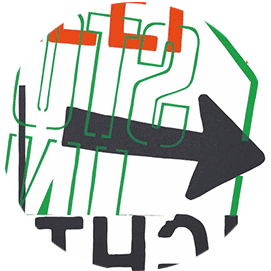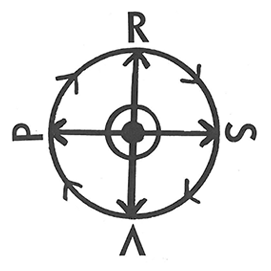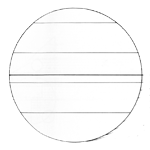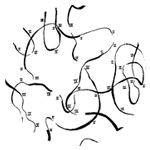The End?
Tactile Paths is modular in nature; as I mention in Chapter 0, its constituent chapters, or paths, can be traversed in any order. It might therefore seem odd to offer a conclusion, since readers are encouraged to wander the website as, and as long as, they please. But despite the fact that the dissertation may not have a linear internal structure, the reader’s experience does, and her own path on and through it is bound to end at some point.
At the same time, embedded within this dissertation is a temporality – or rather multiple temporalities – of inscription. The writing has taken around four years to complete. Fits and starts of in-time improvisation occasionally bubble up to the surface of the website, particularly in creative work such as Seeing the Full Sounding, A Treatise Remix, and my performances of Ben Patterson’s Variations for Double-Bass. If one looks and listens closely to these little bangs (1999), as pianist and composer Frederic Rzewksi calls them, one can observe that Tactile Paths is an entextualization of continuous activity, and not only an assembly of modular parts.
Hidden within that ongoing activity is a minor narrative. The research process began explicitly with practical investigation, and the arguments of early chapters (“Seeing the Full Sounding”; “A Treatise Remix Handbook”) foreground creative media. “Entextualization and Preparation…”, written next, takes personal artistic experience as an object, but does not use it as a discursive partner to such a high degree. “Invitation to Collaborate...” and “Say No Score…“, written toward the end of the research process, do not deal directly with my own practice; rather, they part from perspectives developed through practice in earlier chapters, centering on a more theoretical approach. (More on this below in “Unexpected Turns”.)
For these reasons, it seems both fair and potentially profitable to work with linear experience here rather than ignore it, and find an ending. That is what I shall attempt to do in the remainder of Chapter Ω. I do so in full embrace of the fact that the reader might begin with this chapter, just as she might end with Chapter 0, or never read it at all. But no matter – what interests me here, following philosopher Gary Peters, is finding “new beginnings again, and again… eternally” (2009, 170). So, without further ado…
Review
In this dissertation, I have explored a range of experimental and contemporary musics that employ notation for improvisers. Much of it I have played and/or composed; where this is not the case, my theoretical approach to the work has proceeded from the perspective of a practicing artist. This has enabled me to access information about notation for improvisers on the ground that might otherwise be obscured.
The diverse examples I have analyzed – pieces by Malcolm Goldstein, Cornelius Cardew, Ben Patterson, Richard Barrett, Lawrence Halprin, Bob Ostertag, and myself – do not by any means exhaustively represent the field of notation for improvisers. Nor do they represent, as I explain in Chapter 0 (“Objectives and Criteria”), the potentially infinite number of subcategories imaginable within the field. Rather, I believe they reflect a cross-section of issues relevant to a much wider field of artistic practice than that of these artists alone. The hope is therefore to stimulate discussion among a wider variety of readers than if I had attempted an overview.
My explorations of the examples mentioned above have been guided by the following research questions, first set out in Chapter 0:
- What aspects of improvising can be fruitfully addressed through notation?
- In what ways and to what extent can notation incorporate improvisers’ unique and embodied performance practices into the compositional process?
- If, for the improviser, music is fundamentally unscripted – or unscriptable – why would she compose or perform with notation at all? What kind of scripts fit in her environment?
- How can composer-improvisers use notation to share, challenge, or transform their own ways of improvising? How does this affect and transform my practice?
- How does notation construct, deconstruct, or reconstruct improvisers’ relationships to each other? How do performers listen to each other differently with and without a score?
- How does music involving notation for improvisers encourage us to rethink the way we conceptualize and talk about musical labor?
At the beginning of the research process, each question was tethered to a particular chapter, and by extension, to a particular piece or project (in order): Apples Are Basic (Chapter 0), Goldstein’s Jade Mountain Soundings and on and on and always slowly nowhere, Cardew’s Treatise, Patterson’s Variations for Double-Bass, Barrett’s fOKT and Halprin’s The Sea Ranch, and finally Bob Ostertag’s Say No More. Working through these cases, I came to the following conclusions:
- The richest aspects of improvisation that can be most fruitfully addressed by notation reside first and foremost in the improviser herself – or, borrowing from anthropologist Tim Ingold, the wayfarer (2007, 75) – for whom the practice of improvising is not an on/off switch but rather a way of being in the world. Improvisers embrace the contingencies of their instruments, each other, and other aspects of their environment as creative resources. Therefore composers of notation for improvisers would do well to focus on and respect these contingencies, as well as account for how scores themselves might be used differently and thus change in the context of actual practice. In Tactile Paths I have shown several examples of composers who have (already) done so.
- One way in which improvisers’ unique and embodied performance practices can be incorporated into the compositional process is by foregrounding the physicality of both notation and improvisation. As a kind of ground zero for improvisation, the dynamic kinetic coupling of performers to instruments provides an important resource for notation; it is most accessible through notation that shows rather than tells. Such scores highlight the performative capacity of notation – i.e. its ability not only to transmit, but to co-produce meaning in interaction with the performer. Just as a score is “encountered”, “played”, or “manipulated” by a performer, the performer is “affected”, “influenced”, and “directed” by the score.1
- Improvisers often choose notation in order to transform or expand their own materials and methods. Thus, scores that question and create more possibilities for those materials and methods fit best within improvisers’ environments. A basic respect and sympathy for the score is necessary for this transformation to occur; however, integrity in performance cannot be measured on the axis of faithfulness to either symbols on the page or performers’ own musical identities. Rather, integrity consists in a rigorous exploration of the process of transformation itself.
- In order to share, challenge, or transform their own ways of improvising, composer-improvisers entextualize their ongoing improvisatory practices, rather than simply prescribing or preserving them. Notation need not generate an improvisational situation in order to engender or inflect one. This understanding has brought me to engage and reflect a more experimental, improvisational attitude to conceiving and preparing music as both a composer and performer, beyond improvisation in concert performance.
- Notation constructs, reconstructs, and deconstructs improvisers’ relationships to each other by plugging into their own tacit microsocialities (Born 2017, 52), or social relations during performance. It can challenge and enrich existing collective performance practices by re- or decontextualizing them. Scores may create resistance between improvisers initially, but after some time the resistance might diminish or become productive. Nevertheless, even after performers internalize the mechanisms of a score, they may still use notation to reflect on or alter group dynamics as necessary.
- Music involving notation for improvisers encourages us to rethink the way we conceptualize and talk about musical labor by playing with the role of written notation in project- and performer-specific ways. Scores for improvisers may cut, or add resistance to, tactile connections between improvisers and their instruments; they may index interpersonal dynamics without prescribing them; they may not only consist of notation per se, but also of other media and the environment of performance itself; and they constantly blur the distinctions between the work of composition and performance.
Unexpected Turns
Over the course of the research process, these insights – and retrospectively the research questions – have overlapped to an unexpected degree. For example, whereas I began considering Goldstein’s music mainly in the light of physicality, I later discovered the relevance of questions around entextualization brought up by Patterson’s Variations for Double-Bass. And vice-versa: although I initially chose Patterson’s work as an occasion to investigate the role of improvisation in notation itself, an examination of the physical work that went into my performances of Variations revealed a stronger affinity to Goldstein’s music than I had imagined. Readers will find such orthogonal connections throughout Tactile Paths, and the circular structure of the website (including Topics, or tags) is meant to reinforce them.
This thematic interpenetration can be taken as a consequence of greater familiarity with the material in a general sense; as my own knowledge deepened, finer and more plentiful connections arose. This is, one would think, to be expected. But it is also closely related to a drift in my methods that occurred while carrying out the research – the minor narrative I mentioned above. As I moved gradually from a practice-based approach in earlier chapters toward more speculative theoretical reflection in later chapters, critical distance afforded a broader scholarly context for my objects. All the same, later chapters are still firmly rooted in practical experience, which was in turn sharpened through reflection and exegesis in the earlier chapters. Ultimately, then, both ends of the drift, first-person immersion and external observation, enrich each other. Furthermore, they are essential to portraying a body of work that includes but is much larger than my own music.
Ironically, being enmeshed in these issues from multiple perspectives has not increased my commitment to composing with or performing notation for improvisers as such. Certainly the research has refined my sense of what this body of work has to offer and how to work with it; this music remains an integral part of my artistic life, and I intend to continue advocating for it. But the more urgent aggregate takeaway has been a renewed emphasis on the continuity and value-neutrality of notation and improvisation as parts of a larger creative landscape. In other words, I feel as free as ever to notate and improvise, together or separately, or not, as a given creative situation demands.
As an artist I am involved in many types of projects outside notation for improvisers, such as through-composed chamber music, radio art, curating concerts, and producing sound experiences in non-artistic contexts. Even during the writing of Tactile Paths I worked on several such projects. For example, I composed, toured, and recorded a piece with Charlie Morrow based on a book by André Breton entitled Arcanum 17, which brings together sustained-tone music in just intonation for contrabass and tuba, field recordings, and texts in a 3D sound system.2 I also composed a coffee ritual performance based on cave paintings for and with the experimental music theater group Maulwerker.3 In February 2016 I co-composed and performed in a radio piece recorded on trains in the Czech Republic with sound artist Christina Kubisch.4 Since October 2016 I have been pursuing an immersive sound project for the remodeled San Francisco airport.
None of these projects meaningfully employs notation for improvisers in the senses put forward in the dissertation. However, they do in their own ways touch on themes of ecology, distributed memory, and/or the magic of inscription; my understanding of all these themes has been developed through writing Tactile Paths. Having brought the core of the present research project to a (temporary) close, I now wish pursue these threads further, and see how they might loop back to the methods covered here on their own.
The final surprise discovery made through the research process concerns the name of the dissertation. I had originally envisioned the notion of tactility (along with its sister terms embodiment, physicality, and sensuality) to comprise one of three main topics which together would form a kind of thematic umbrella over all the work analyzed here. (The others were group performance practice and time.) Toward the middle of writing the dissertation, however, it became increasingly difficult to separate this notion from the other two. As improvisation scholars Vincent Meelberg and Vijay Iyer have pointed out, physical movement and awareness are tightly coupled to group performance practice (Meelberg 2014) and in-time experience (Iyer 1998) in improvised music, reflecting how improvisers “think” through their bodies with each other in real time. Tactility’s near ubiquity in this music – with or without notation – and its embeddedness in the other themes led me to abandon the three topics as a central axis. Although I have chosen not to elaborate the concept of tactility a great deal per se, I have examined tactility’s presence and impact in the context of individual pieces and projects at length. For this reason, I believe Tactile Paths remains an apt title.
Political App-/Implications
Within the sphere of contemporary music, I believe many of the insights described above can help undo a debilitating conventional opposition of notated and improvised music in institutions and musical culture. Particularly in Germany, where I have lived since 2009, a division between the worlds of contemporary through-composed new music and (free) improvised music persists in festivals, education, funding structures, and GEMA (the national authors’ rights organization). This division hangs in large part on the positioning of notation as an (in my opinion imaginary) buffer between the perpetually contested categories of composition and improvisation. While some practitioners and cultural actors may not see this as a problem, I do. In my opinion this gap both fails to reflect the hybridity of current contemporary and experimental music practice, as evidenced by the music discussed in Tactile Paths, and deincentivizes shared discourse across stylistic and methodological boundaries. The negative economic effects for artists and the negative social effects for audiences wrought by such a separation must be redressed. I hope the findings of this research catalyze change in some small way, by showing – not only on a theoretical plane – how notation and improvisation are compatible and mutually beneficial.
Beyond the musical sphere, notation for improvisers also has a social-metaphorical value that should not be overlooked. Much contemporary literature on experimental improvisation prizes the role of empathy, mutuality, processuality, a community-centered ethos, and democratic values. I agree with aspects of this literature, particularly in the cases of writers who take practical knowledge seriously and are careful not to romanticize or uncritically overstate the virtues of improvisation as a force for good in the world. Nonetheless, as emphasized in “Invitation to Collaborate…”, I strongly disagree with practitioners and scholars who argue for these qualities in opposition to notation, which may be explicitly or implicitly cast as elitist, hegemonic, and/or rigid by its very nature.
The music in Tactile Paths clearly refutes this characterization by showing that notation can expand, deepen, and pry open new spaces for improvisation. In this sense it deepens and challenges the emancipatory discourse around improvisation. Rather than framing improvisation as an inclusive, non-hierarchical, self-sufficient alternative to regulatory, hierarchical, discriminatory written laws, we might think of notation as a tool with which improvising communities navigate, inflect, and potentially change the existing order. Notation can be thought of as paths that enable community building or agreements between neighbors that lead to lasting peace.
To be sure, I do not wish to stretch the social-metaphorical aspect of notation for improvisers too far, but others are welcome to pick up this thread. I would point out to any such politically minded scholars that the conditions of empathy, mutuality, etc. mentioned above are rarely a guarantor of aesthetic success. Often these conditions are prerequisites, but ultimately successful employment of notation for improvisers, as in most music, depends on a host of other factors both internal and external to the work and working process. These include personnel, materials, technical questions, the circumstances of preparation and presentation, and – as we see in Bob Ostertag’s case – many other factors beyond the artists’ control or awareness. Thus, I am of the opinion that aesthetic success should be measured as often as possible on a case-by-case basis. Perhaps this statement has direct political relevance after all.
I can only hope that readers are also inspired to bring the insights achieved in Tactile Paths to bear on their own practices and lives in ways I have not foreseen. If they do, I will consider my metascore to have worked… for now.
- The performativity of musical scores is a rich topic that I have dealt with in a book chapter entitled “Three Performances: A Virtual (Musical) Improvisation” (Maschat and Williams 2016). Musicologist Mathias Maschat and I argue that even before public concert performance occurs, scores (and written texts more generally) can exhibit liveness by spurring interaction with the reader through structural tensions and ambiguities. Likewise, the reader can engage in a “performance-reading” of certain scores by making temporal sense of them in ways that require actively navigating or supplementing the text.
- Arcanum 17 http://www.arcanum17.wordpress.com.
- What Hole Is This? http://www.christopherisnow.com/portfolio/what-hole-is-this.
- Groundwave Rondo (Magnetic Travelling) http://www.rozhlas.cz/radiocustica_english/project/_zprava/christina-kubisch-christopher-williams-groundwave-rondo-magnetic-traveling–1584797.
References
- Born, Georgina. 2017. “After Relational Aesthetics: Improvised Musics, the Social, and (Re)theorising the Aesthetic.” In Improvisation and Social Aesthetics, edited by Georgina Born, Eric Lewis, and Will Straw. Durham, NC: Duke University Press.
- Ingold, Tim. 2007. Lines: A Brief History. New York: Routledge.
- Iyer, Vijay. 1998. “Microstructures of Feel, Macrostructures of Sound: Embodied Cognition in West African and African-American Musics.” PhD Dissertation, University of California, Berkeley.
- Maschat, Mathias, and Christopher Williams. 2016. “Three Performances: A Virtual (Musical) Improvisation.” In Experiencing Liveness in Contemporary Performance, edited by Matthew Reason and Anja Mølle Lindelof, 242–53. London: Routledge.
- Meelberg, Vincent. 2014. “Musical Improvisation as the Performance of Embodied Knowledge: Embodied Narrativity in Musical Performance.” In Proceedings of CARPA3: Colloquium on Artistic Research in Performing Arts, edited by Annette Arlander. Helsinki: University of the Arts Helsinki, Theatre Academy. https://www.academia.edu/6854151/Musical_Improvisation_as_the_Performance_of_Embodied_Knowledge_Embodied_Narrativity_in_Musical_Performance.
- Peters, Gary. 2009. The Philosophy of Improvisation. Chicago: University of Chicago Press.
- Rzewski, Frederic. 1999. “Little Bangs: A Nihilist Theory Improvisation.” Current Musicology 67/68: 377.



